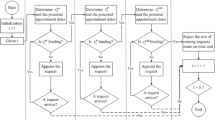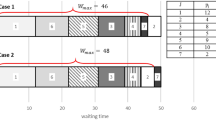Abstract
No-shows and non-punctual appointments have always been uncertain factors faced by managers of service-oriented enterprises and institutions, which usually lead to a low utilization rate of resources and a rapid decline in service satisfaction. Taking clinics as an example, this paper proposes a novel and efficient real-time sequencing strategy to minimize the cost associated with patient waiting time, provider idle time and overtime considering no-shows and unpunctuality. Four types of patient waiting time are considered for the first time, based on which the developed real-time sequencing strategy is used for scheduling the waiting patients when the provider becomes idle. Then, a biased random-key genetic algorithm is adopted to determine the number of patients on appointment slots and the length of each appointment slot. Extensive computational experiments show that the derived real-time sequencing strategy achieves a significant cost reduction compared with the famous FCFS (first come first served) and the state-of-art LAR (the larger of appointment time and real arrival time) rules.







Similar content being viewed by others
References
Alexopoulos, C., Goldsman, D., Fontanesi, J., Kopald, D., & Wilson, J. R. (2008). Modeling patient arrivals in community clinics. Omega, 36(1), 33–43.
Bean, C. J. (1994). Genetic algorithm and random keys for sequencing and optimization. ORSA Journal on Computing, 6(2), 154–160.
Cayirli, T., & Emre, V. (2003). Outpatient scheduling in health care: A review of literature. Production and Operations Management, 12(4), 519–549.
Cayirli, T., Veral, E., & Rosen, H. (2008). Assessment of patient classification in appointment system design. Production and Operations Management, 17(3), 338–353.
Chen, R. R., & Robinson, L. W. (2014). Sequencing and scheduling appointments with potential call-inpatients. Production and Operations Management, 23(9), 1522–1538.
Chen, Y., Kuo, Y. H., Fan, P., & Balasubramanian, H. (2018). Appointment overbooking with different slot structures. Computers and Industrial Engineering, 124, 237–248.
Daggy, J., Lawley, M., Willis, D., Thayer, D., Suelzer, C., DeLaurentis, P. C., Turkcan, A., Chakraborty, S., & Sands, L. (2010). Using no-show modeling to improve clinic performance. Health Informatics Journal, 16(4), 246–259.
Dantas, L. F., Fleck, J. L., Oliveira, F. L., & Hamacher, S. (2018). No-shows in appointment scheduling–a systematic literature review. Health Policy, 122(4), 412–421.
Deceuninck, M., De Vuyst, S., & Fiems, D. (2019). An efficient control variate method for appointment scheduling with patient unpunctuality. Simulation Modelling Practice and Theory, 90, 116–129.
Deceuninck, M., Fiems, D., & Vuyst, S. D. (2018). Outpatient scheduling with unpunctual patients and no-shows. European Journal of Operational Research, 265(1), 195–207.
Drupsteen, J., van der Vaart, T., & van Donk, D. P. (2013). Integrative practices in hospitals and their impact on patient flow. International Journal of Operations and Production Management, 33(7), 912–933.
Fontes, D. B. M. M., Homayouni, S. M., & Gonçalves, J. F. (2023). A hybrid particle swarm optimization and simulated annealing algorithm for the job shop scheduling problem with transport resources. European Journal of Operational Research, 306(3), 1140–1157.
Gao, K. Z., Yang, F. J., Zhou, M. C., Pan, Q. K., & Sugnathan, P. N. (2018). Flexible job-shop rescheduling for new job insertion by using discrete jaya algorithm. IEEE Transactions on Cybernetics, 49(5), 1944–1955.
Goncalves, J. F., & Resende, M. G. C. (2011). Biased random-key genetic algorithms for combinatorial optimization. Journal of Heuristics, 17(5), 487–525.
Guy, R., Hocking, J., Wand, H., Stott, S., Ali, H., & Kaldor, J. (2012). How effective are short message service reminders at increasing clinic attendance? A meta-analysis and systematic review. Health Services Research, 47(2), 614–632.
Harper, P. R., & Gamlin, H. M. (2003). Reduced outpatient waiting times with improved appointment scheduling: A simulation modelling approach. Or Spectrum, 25(2), 207–222.
Hassin, R., & Mendel, S. (2008). Scheduling arrivals to queues: A single-server model with no-shows. Management Science, 54(3), 565–572.
Jiang, B. W., Tang, J. F., & Yan, C. J. (2019). A stochastic programming model for outpatient appointment scheduling considering unpunctuality. Omega, 82, 70–82.
Klassen, K. J., & Yoogalingam, R. (2009). Improving performance in outpatient appointment services with a simulation optimization approach. Production and Operations Management, 18(4), 447–458.
Klassen, K. J., & Yoogalingam, R. (2014). Strategies for appointment policy design with patient unpunctuality. Decision Sciences, 45(5), 881–911.
Lee, S.-Y., Chinnam, R. B., Dalkiran, E., Krupp, S., & Nauss, M. (2020). Proactive coordination of inpatient bed management to reduce emergency department patient boarding. International Journal of Production Economics. https://doi.org/10.1016/j.ijpe.2020.107842
Liu, J. Y., Xie, J. G., Yang, K. K., & Zheng, Z. C. (2019). Effects of rescheduling on patient no-show behavior in outpatient clinics. Manufacturing and Service Operations Management, 21(4), 780–797.
Ma, X., Zhao, X., & Guo, P. (2021). Cope with the COVID-19 pandemic: Dynamic bed allocation and patient subsidization in a public healthcare system. International Journal of Production Economics. https://doi.org/10.1016/j.ijpe.2021.108320
Millhiser, W. P., & Veral, E. A. (2015). Designing appointment system templates with operational performance targets. IIE Transactions on Healthcare Systems Engineering, 5(3), 125–146.
Murray, M., Bodenheimer, T., Rittenhouse, D., & Grumbach, K. (2003). Improving timely access to primary care-case studies of the advanced access model. Journal of the American Medical Association, 289(8), 1042–1046.
Muthuraman, K., & Lawley, M. (2008). A stochastic overbooking model for outpatient clinical scheduling with no-shows. IIE Transactions, 40, 820–837.
Pan, X. W., Geng, N., & Xie, X. L. (2021a). A stochastic approximation approach for managing appointments in the presence of unpunctual patients, multiple servers and no-shows. International Journal of Production Research, 59(10), 2996–3016.
Pan, X. W., Geng, N., & Xie, X. L. (2021b). Appointment scheduling and real-time sequencing strategies for patient unpunctuality. European Journal of Operation Research, 295, 246–260.
Pan, Y. X., Gao, K. Z., Li, Z. W., & Wu, N. Q. (2023). Solving biobjective distributed flow-shop scheduling problems with lot-streaming using an improved jaya algorithm. IEEE Transactions on Cybernetics, 53(6), 3818–3828.
Parikh, A., Gupta, K., Wilson, A. C., Fields, K., Cosgrove, N. M., & Kostis, J. B. (2010). The effectiveness of outpatient appointment reminder systems in reducing no-show rates. The American Journal of Medicine, 123(6), 542–548.
Robinson, L. W., & Chen, R. R. (2010). A comparison of traditional and open-access policies for appointment scheduling. Manufacturing and Service Operations Management, 12(2), 330–346.
Rocholl, J., & Mönch, L. (2021). Decomposition heuristics for parallel-machine multiple orders per job scheduling problems with a common due date. Journal of the Operational Research Society, 72(8), 1737–1753.
Sakib, N., Sun, X. X., Kong, N., Masterson, C., Meng, H. D., Smith, K., & Li, M. Y. (2022). Heterogeneous length-of-stay modeling of post-acute care residents in the nursing home with competing discharge dispositions. Frontiers of Engineering Management, 9(4), 577–591.
Samorani, M., & LaGanga, L. R. (2015). Outpatient appointment scheduling given individual day-dependent no-show predictions. European Journal of Operational Research, 240(1), 245–257.
Toso R. F., and Resende M. G. C. A C++ Application Programming Interface for Biased Random-key Genetic Algorithms. 2011 http://mau ricio.resende.info/doc/brkgaAPI.pdf
Xin, Y. T., & Xu, K. Y. (2012). Hospital emergency management research in China: Trends and challenges. Emergency Medicine Journal, 29, 353–357.
Xu, R. H., Zhang, T. T., & Zhang, Q. P. (2022). Investigating the effect of online and offline reputation on the provision of online counseling services: A case study of the Internet hospitals in China. Frontiers of Engineering Management, 9(4), 563–576.
Author information
Authors and Affiliations
Corresponding author
Additional information
Publisher's Note
Springer Nature remains neutral with regard to jurisdictional claims in published maps and institutional affiliations.
Rights and permissions
Springer Nature or its licensor (e.g. a society or other partner) holds exclusive rights to this article under a publishing agreement with the author(s) or other rightsholder(s); author self-archiving of the accepted manuscript version of this article is solely governed by the terms of such publishing agreement and applicable law.
About this article
Cite this article
Li, C., Yang, Z., Yang, F. et al. A novel and efficient real-time sequencing strategy for appointment scheduling with unpunctual patients. J Sched 27, 135–149 (2024). https://doi.org/10.1007/s10951-023-00802-9
Accepted:
Published:
Issue Date:
DOI: https://doi.org/10.1007/s10951-023-00802-9




